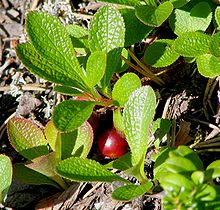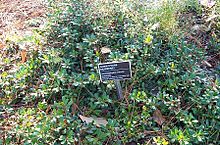- Bearberry
-
Bearberry Arctostaphylos uva-ursi Scientific classification Kingdom: Plantae (unranked): Angiosperms (unranked): Eudicots (unranked): Asterids Order: Ericales Family: Ericaceae Genus: Arctostaphylos Species Arctostaphylos alpina - Alpine Bearberry
Arctostaphylos rubra - Red Bearberry
Arctostaphylos uva-ursi - Common BearberryBearberries are three species of dwarf shrubs in the genus Arctostaphylos. Unlike the other species of Arctostaphylos (see Manzanita), they are adapted to Arctic and sub-Arctic climates, and have a circumpolar distribution in northern North America, Asia and Europe, one with a small highly disjunctive population in Central America.
Contents
Species
The name bearberry derives from the edible fruit said to be consumed by bears.[citation needed] The fruit, also called bearberries, are edible and sometimes gathered for food. The leaves of the plant are used in herbal medicine.[1]
- Alpine Bearberry - A. alpina (L.) Spreng (syn. Arctous alpinus (L.) Niedenzu). A procumbent shrub 10–30 cm high. Leaves not winter green, but dead leaves persist on stems for several years. Berries dark purple to black. Distribution: circumpolar, at high latitudes, from Scotland east across Scandinavia, Russia, Alaska, Canada and Greenland; southern limits in Europe in the Pyrenees and the Alps, in Asia to the Altay Mountains, and in North America to British Columbia in the west, and Maine and New Hampshire in the United States in the east.
- Red Bearberry - A. rubra (Rehd. & Wilson) Fernald (syn. Arctous rubra (Rehder and E.H. Wilson) Nakai; Arctous alpinus var. ruber Rehd. and Wilson). A procumbent shrub 10–30 cm high. Leaves deciduous, falling in autumn to leave bare stems. Berries red. Distribution: in the mountains of Sichuan, southwestern China north and east to eastern Siberia, Alaska and northern Canada east to northern Quebec.
- Common Bearberry - A. uva-ursi (L.) Spreng.
Other recorded old English common names include Arberry, Bear's Grape, Crowberry, Foxberry, Hog Cranberry, Kinnikinnick, Mealberry, Mountain Box, Mountain Cranberry, Mountain Tobacco, Sandberry, Upland Cranberry, Uva-ursi.
Uses in folk medicine
The plant contains arbutin, ursolic acid, tannic acid, gallic acid, some essential oil and resin, hydroquinones (mainly arbutin, up to 17%), tannins (up to 15%), phenolic glycosides and flavonoids.[2]
The leaves are picked any time during the summer and dried for use in infusions, liquid extracts, medicinal tea bags and tablets believed to be potentially effective in folk medicine.
Bearberry is relatively safe, although large doses may cause nausea, green urine, bluish-grey skin, vomiting, fever, chills, severe back pain, ringing in the ears (some people can withstand up to 20g and others show signs of poisoning after just 1g); take no more than 7–10 days at a time.
It should not be used by people who are pregnant, breast feeding, nor in the treatment of children (under 12) and patients with kidney disease. Drug interactions have been recorded with diuretics, as well as drugs that make the urine acidic (such as ascorbic acid and Urex).
Despite these extensive applications in folk medicine, there is no scientific evidence that any of them are effective.[citation needed]
History and folklore
Bearberry was first documented in The Physicians of Myddfai, a 13th century Welsh herbal, it was also described by Clusius in 1601, and recommended for medicinal use in 1763 by Gerhard and others. Often called uva-ursi, from the Latin uva, "grape, berry of the vine", ursi, "bear", i.e. "bear's grape". It first appeared in the London Pharmacopoeia in 1788, though it probably was in use long before.
In Strathnairn, Scotland there is a hill, known as Brin Mains, but which is known in Scottish Gaelic as "Cnoc nan Cnàimhseag" which means "The hill of the Bearberries".
Marco Polo reported in 13th century that the Chinese were using it as a diuretic, to treat kidney and urinary problems. Bearberry leaves are used medicinally in parts of Europe, and are officially classified as a phytomedicine (medicinal herb).[1] Native Americans use bearberry leaves with tobacco and other herbs in religious ceremonies; both as a smudge (type of incense) or smoked in a sacred pipe, it carries the smoker's prayers to the Great Spirit. When mixed with tobacco or other herbs, it is referred to as kinnikinnick, from an Algonquian (probably Delaware) word for "mixture". Among the ingredients in kinnikinnick, they used non-poisonous sumac leaves,[3] and the inner bark of certain bushes such as red osier dogwood (silky cornell),[3] chokecherry, and alder, to improve the taste of the bearberry leaf.[4]
Native Americans used bearberry tea to treat inflammation of the urinary tract, urethritis, kidney stones, and cystitis. The Cheyenne use the tea to treat back sprains. Some Native American tribes powder the leaves and apply them to sores. Other tribes drink it to treat venereal diseases. The berries are also made into a tea that is used to ward off obesity. Early European settlers in the Americas used the leaves taken internally as an astringent to treat nephritis, kidney stones and other diseases of the urinary system.
Sources
- "Mountain Nature". http://www.mountainnature.com/. Ward Cameron Enterprises. http://www.mountainnature.com/Plants/PlantsLatinNameResult.asp?ID=125.
Footnotes
- ^ a b Pegg, Ronald B.; Rybarczyk, Anna and Amarowicz, Ryszard (2008) "Chromatographic Separation of Tannin Fractions from a Bearberry-leaf (Arctostaphylos Uva-ursi L. Sprengel) Extract by Se-hplc – a Short Report" Polish Journal of Food and Nutrition Sciences 58(4): pp. 485–490
- ^ Hänsel, Rudolf; Keller, K.; Rimpler, H.; and Schneider, G. (1992) "Uvae ursi folium (Bärentraubenblätter)" In: Hagers Handbuch der pharmazeutischen Praxis: 4, Drogen A - D (5th Edition) Springer-Verlag, Berlin, pp. 330–336, ISBN 3-540-52631-5
- ^ a b Upham, Warren (2001) Minnesota place names: a geographical encyclopedia (3rd edition) Minnesota Historical Society Press, St. Paul, Minnesota, page 481, ISBN 0-87351-396-7
- ^ Staff (2009) "Bearberry" Discovering Lewis and Clark The Lewis and Clark Fort Mandan Foundation
Categories:- Arctostaphylos
- Flora of Canada
- Medicinal plants
- Flora of Oregon
Wikimedia Foundation. 2010.




